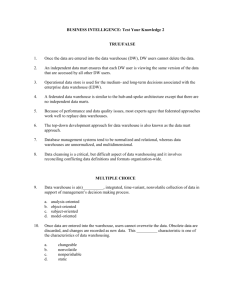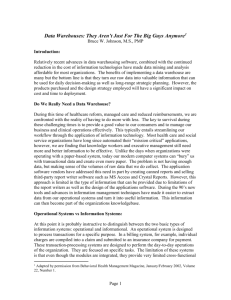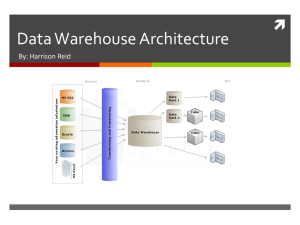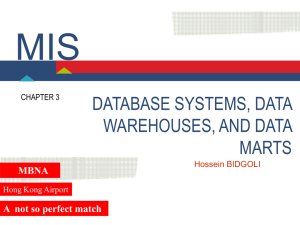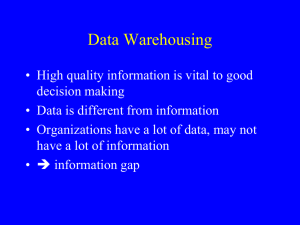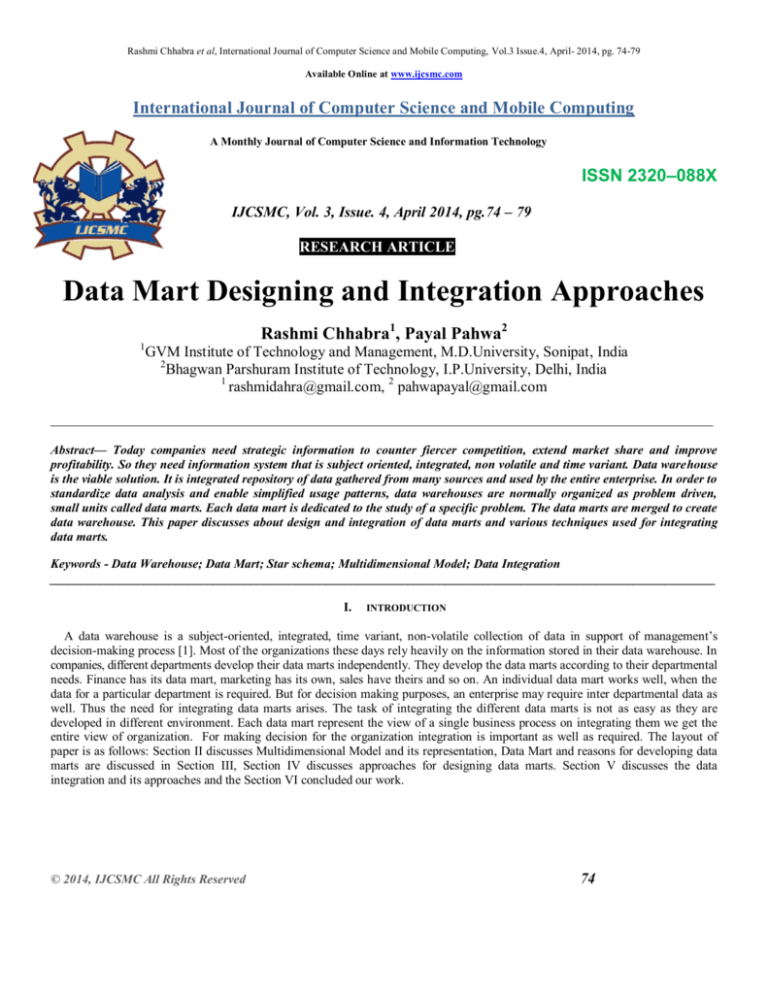
Rashmi Chhabra et al, International Journal of Computer Science and Mobile Computing, Vol.3 Issue.4, April- 2014, pg. 74-79
Available Online at www.ijcsmc.com
International Journal of Computer Science and Mobile Computing
A Monthly Journal of Computer Science and Information Technology
ISSN 2320–088X
IJCSMC, Vol. 3, Issue. 4, April 2014, pg.74 – 79
RESEARCH ARTICLE
Data Mart Designing and Integration Approaches
1
Rashmi Chhabra1, Payal Pahwa2
GVM Institute of Technology and Management, M.D.University, Sonipat, India
2
Bhagwan Parshuram Institute of Technology, I.P.University, Delhi, India
1
rashmidahra@gmail.com, 2 pahwapayal@gmail.com
________________________________________________________________________________________________
Abstract— Today companies need strategic information to counter fiercer competition, extend market share and improve
profitability. So they need information system that is subject oriented, integrated, non volatile and time variant. Data warehouse
is the viable solution. It is integrated repository of data gathered from many sources and used by the entire enterprise. In order to
standardize data analysis and enable simplified usage patterns, data warehouses are normally organized as problem driven,
small units called data marts. Each data mart is dedicated to the study of a specific problem. The data marts are merged to create
data warehouse. This paper discusses about design and integration of data marts and various techniques used for integrating
data marts.
Keywords - Data Warehouse; Data Mart; Star schema; Multidimensional Model; Data Integration
__________________________________________________________________________________________________________
I.
INTRODUCTION
A data warehouse is a subject-oriented, integrated, time variant, non-volatile collection of data in support of management’s
decision-making process [1]. Most of the organizations these days rely heavily on the information stored in their data warehouse. In
companies, different departments develop their data marts independently. They develop the data marts according to their departmental
needs. Finance has its data mart, marketing has its own, sales have theirs and so on. An individual data mart works well, when the
data for a particular department is required. But for decision making purposes, an enterprise may require inter departmental data as
well. Thus the need for integrating data marts arises. The task of integrating the different data marts is not as easy as they are
developed in different environment. Each data mart represent the view of a single business process on integrating them we get the
entire view of organization. For making decision for the organization integration is important as well as required. The layout of
paper is as follows: Section II discusses Multidimensional Model and its representation, Data Mart and reasons for developing data
marts are discussed in Section III, Section IV discusses approaches for designing data marts. Section V discusses the data
integration and its approaches and the Section VI concluded our work.
© 2014, IJCSMC All Rights Reserved
74
Rashmi Chhabra et al, International Journal of Computer Science and Mobile Computing, Vol.3 Issue.4, April- 2014, pg. 74-79
II. MULTIDIMENSIONAL MODEL
The n-dimensional view of data is modeled using a multidimensional model[2]. A multidimensional data model is typically
organized around a central theme transaction. The basic components of a multidimensional model are fact and dimensions. Fact
table consist of the measurement, matrices or facts of a business process. It provide the additive values that act as independent
variables by which dimensional attributes are analyzed. The facts are numerical measures like quantity, amount etc. . In fig. 1 Sales
fact table quantity sold, sales amount and cost amount are the facts. Facts are usually quantities, which are used for analyzing
relationship between dimensions. Dimensions are the perspective entities with respect to which organizations would like to keep
records [6]. For example a Bank may create a customer warehouse in order to keep records of the customers with respect to the
dimensions namely time, transaction, branch and location. Each dimension may have a table associated with it, called the dimension
table. There are two basic approaches to multidimensional modeling one is star schema and other is cube [10]. Conceptually a MDB
uses the idea of data cube to represent the dimensions of data available to a user. These two approaches are discussed below.
A. Star Schema
The star schema is the simplest data warehouse schema, consisting of a single "fact table" with a compound primary key, with
one segment for each "dimension" and with additional columns of additive, numeric facts. The name star schema is derived from the
fact that the schema diagram is shaped like a star.The star schema makes multi-dimensional database (MDDB) functionality
possible using a traditional relational database. Because relational databases are the most common data management system in
organizations today, implementing multi-dimensional views of data using a relational database is very appealing. Even if a specific
MDDB solution is used, its sources likely are relational databases.Another reason for using star schema is its ease of understanding.
Fact tables in star schema are mostly in third normal form (3NF), but dimensional tables are in de-normalized second normal form
(2NF). A start schema is represented in fig. 1 where Sales is the fact table. Account, Time, Product and Geography are the
dimension tables and Dollar Amount and units are the measure.
Product
Time
Product_id
Brand
category
Sales Fact
Product
Day
Store
Promotion
Day
Month
Week
Year
Quantity sold
Sales Amount
store
Store_id
City
state
Cost Amount
Promotion
Mediatype
Pricetype
Fig. 1. Star Schema of Sales Data Mart
B. Cube
A data cube[10] is defined over a multidimensional space and consists of several dimensions representing the various
perspectives of data. The data cube contains points or cells that are measures or values which represent a set of dimensions[9]. For
example, consider a retail sales application where the dimensions of interest may include Product, Location and Time dimensions. A
cell corresponds to the value for the corresponding Product, Location and Time. If the measure of interest in this application is sales
amount, then a point represents the sales measure corresponding to the Product, Location and Time dimensions.
© 2014, IJCSMC All Rights Reserved
75
Rashmi Chhabra et al, International Journal of Computer Science and Mobile Computing, Vol.3 Issue.4, April- 2014, pg. 74-79
P
1
Product
P
2
1996
P
3
1995
1994 Time
NPQ
XYZ
ABC
Location
Fig. 2. Cube representation of Sales Data Mart
In Fig. 2 , the shaded cell corresponds to sales for Product `PI’ in `ABC’ for 1994 .
III. DATA MARTS
The data mart has evolved from the data warehouse concept. It is a small data warehouse that satisfies the needs of a reduced set
of users [4]. It is a specific, subject oriented, repository of data designed to answer specific questions for specific users. It is a
collection of subject areas organized for decision support based on the needs of a given department. It only contains the specific data
for local analysis. It is a simpler form of a data warehouse focused on a single subject (or functional area) such as sales, finance,
marketing, HR etc. It represents data from single business process. There are many reasons for creating data mart .
TABLE I
REASONS FOR CREATING DATA MARTS
Reasons for creating Data Marts
It is easy to create data
marts as it is specific to a
particular subject.
Response time
Improves
response time.
Lower cost
Lower
cost
than
implementing a full Data
warehouse.
Enhancement
Simplicity
Scope
easy to enhance over time
concentrate on a single
subject.
easy to understand, as
scope is limited
Ease of creation
© 2014, IJCSMC All Rights Reserved
end-user
76
Rashmi Chhabra et al, International Journal of Computer Science and Mobile Computing, Vol.3 Issue.4, April- 2014, pg. 74-79
Due to the above mentioned reasons data mart strategy can mitigate the risk, limit the expense, and reduce the time required to
deliver data warehouse functionality. Data marts are typically application-specific databases designed to address particular question
spaces, not to be data repositories this differs from most relational schemas, which generally act as source systems and are designed
for redundancy and performance. There are various approaches for designing data marts.
IV. APPROACHES FOR DESIGNING DATA MARTS
There are mainly two approaches for designing data marts. These approaches are discussed below:
A. Dependent data marts
The first approach is to build dependent data marts (DDM). A dependent data mart is a logical subset or a physical subset of a
larger data warehouse. According to this approach the data marts are treated as the subsets of a data warehouse [3]. In this approach,
firstly a data warehouse is created from which further different data marts can be generated. These data marts are dependent on the
data warehouse and extract the necessary data from it. In this approach as the data mart is created by data warehouse therefore there
is no need of data mart integration. It is also known as top down approach. The fig. 3 represents DDM
Data
Mart
Data
Warehouse
Data
Mart
Data
Mart
Fig. 3. Dependent Data Mart
B. Independent data marts
The second approach is independent data marts (IDM) Here, firstly independent data marts are created and then a data warehouse
is designed using these independent multiple data marts [4]. In this approach as all the data marts are designed independently
therefore integration of data marts is required. It is also termed as bottom up approach as the data marts are integrated to design a
data warehouse. The fig.4 represent IDM.
Data
Mart
Data
Mart
Data
Warehouse
Data
Marts
Fig. 4. Independent Data Mart
© 2014, IJCSMC All Rights Reserved
77
Rashmi Chhabra et al, International Journal of Computer Science and Mobile Computing, Vol.3 Issue.4, April- 2014, pg. 74-79
V. DATA INTEGRATION
Data integration is the process of combining data residing at different sources and providing the user with a unified view of this
data.[5]. This process emerges in a variety of situations both commercial (when two similar companies need to merge their
databases) and scientific (combining research results from different bioinformatics repositories). Data integration appears with
increasing frequency as the volume and the need to share existing data explodes.There are different approaches for data integration.
A. Integration with Dimension Sharing.
A dimension of different data marts is shareable when the dimension is same in both the data marts. Having shareable
dimensions and facts is important because it gives the ability to integrate the data marts and to combine and correlate such data. In
particular, integration is based on joining multiple data marts over common dimensions [4]. Suppose we have a Sales data mart with
dimensions Customer, Time and Store . Also let us have a second data mart named as Store Invention with dimensions Product and
Store. To integrate these two data marts we choose a dimension that is common in both the data marts i.e. store, as the store is exactly
the same dimension in both the data marts.
B. Integration with dimension compatibility
In this section, we discuss the impact of dimension compatibility on integration. According to this view two dimensions of
different data marts are compatible when their common information is consistent. Similarly, two facts are compatible when their
contents can be combined in a meaningful way. Having compatible dimensions and facts is important because it gives the ability to
look consistently at data across data marts and to combine and correlate such data. [7][8]. Suppose we have a Sales data mart with
dimensions Customer, Time and Store and the other data mart Warehouse Inventory data mart with dimensions Product and
warehouse. Both the dimensions Store and Warehouse have common attribute say city. Before integrating them, they need to be
aggregated over the common city level in the compatible dimensions Store and Warehouse.
C. Integration with generalization
As already discussed that to integrate data marts either the data marts share the exactly same dimension or they must be dimension
compatible. According to above approaches we are unable to integrate the data marts if the dimensions are not same. However we
argue that it is also possible to integrate data marts and drill across them if dimensions are not exactly the same [5] . If this is the case ,
semantic relationship should exit between the dimensions in the stars. Dimensions of different stars could be related by Generalization
so that integration would be allowed. For instance Customer and Clerk are both specialization of People. Therefore we could travel
from a star with Customer dimension to another one with Clerk dimension, if their sets of instances are not disjoint. This approach is
suitable when the dimensions are not compatible. In the Fig 5 we can specialize People dimension at SaleRole level to get Clerk
dimension which contains a level (i.e. clerk) with instances corresponding to people acting as clerks and another one with only one
instance representing the set of all clerks.
Fig. 5. Integration with generalization
© 2014, IJCSMC All Rights Reserved
78
Rashmi Chhabra et al, International Journal of Computer Science and Mobile Computing, Vol.3 Issue.4, April- 2014, pg. 74-79
VI. CONCLUSION
There are situations when data from different organization should merged for decision making purposes. That is only possible
when two different data warehouse / data marts share a common dimension. We have shown the possibilities to combine different
data marts. There are mainly two approaches of designing data marts one is dependent data mart and the other is independent data
mart. The integration of data marts is required in case of independent data marts as they are created in different environment. There
are other approaches of designing data marts like hybrid approach and federated approach. This paper discusses designing and
integration of data marts. We emphasis on the design of data marts and requirement of integrating them.
REFERENCES
[1] W.H.Inmon Building the Data Warehouse. John Wiley and Sons, Secon Edition 1996.
[2] L.Cabibbo and R.Torlone. A logical approach to multidimensional databases,1998
[3] W.H. Inmon . Building the Data warehouse.John Wiley & Sons, Second Edition 1996.
[4] Ralph Kimball. The data warehouse tool kit , John wiley & sons, 1996.
[5] A.Abello, J. Samos, F. Saltor. On Relationships Offering New Drill Across Possibilities. In Int. Workshop on
Data Warehousing and OLAP (DOLAP2002), ACM (2002).
[6] A.Abello, J. Samos, F. Saltor. Understanding facts in a multidimensional Object-Oriented Model. In Proc. of
the 4th Int. Workshop on Data warehousing and OLAP (DOLAP), pages 32-39, ACM press, 2006.
[7] L.Cabibbo and R.Torlone. On the integration of autonomous data marts.16th Int .Conference on Scientific and
Statistical Database Management (SSDBM’04), 2004.
[8] L.Cabibbo and R.Torlone .Dimension compatibility for data mart integration. SEBD, 2004, Pages 6-17.
[9] A.Datta and H.Thomas .The Cube Data model: A conceptual model and Algebra for on-line Analytical
Processing in Data warehouses. In proceedings of the 7th workshop on Information Technologies and Systems
(WITS’97), pages 91-100, 1997.
[10] J.C. Trujillo. The GOLD model: An Object Oriented Multi-dimensional data model for Multi-dimensional
databases, 1999.
© 2014, IJCSMC All Rights Reserved
79


